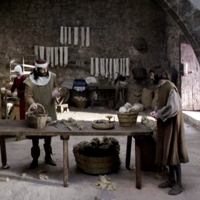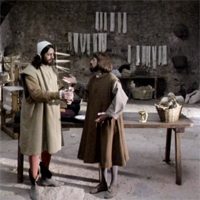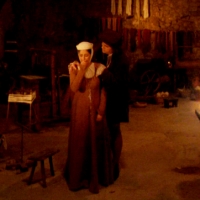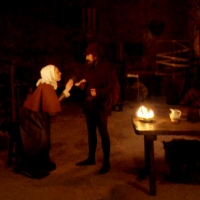-
 A host city (year 1316)
A host city (year 1316)Valencia was the destination for large contingents of people during the entirety of the Middle Ages. These people came primarily from the regions of Catalonia and Aragon, but also from farther-away territories and from Valencia's own kingdom. Some were able to integrate themselves into the city, especially businessmen, artisans, clergy and knights. Trade and common backgrounds were the basis through which many people socialized as they grew accustomed to the city.
-
 Pottery production (year1316)
Pottery production (year1316)One of the crafts that enjoyed great success after the conquest was pottery. The manufacture of pottery was concentrated in the towns surrounding Valencia, especially Paterna and Manises, and stretched as far out as Grao. After the first period, which favored crude pottery, the workshops began to specialize in decorated china, which became very popular at the end of the eighth century.
-
 Textile manufacturing (year 1316)
Textile manufacturing (year 1316)A textile craft was developed rapidly across the fourteenth century until it became the primary industry of medieval Valencia, concerned as much with local consumption as it was with exportation. The production of wool fabrics included numerous phases, from the shearing of the sheep to the finalization of the cloths, each of which required a separate job. It required many years of practice, first as an apprentice and then as an official, until one reached the level of expertise necessary to take the exam for a master’s degree, a requisite for opening one’s own workshop.
-
 Attack on the Jewish quarter (year 1391)
Attack on the Jewish quarter (year 1391)Although we often speak of the coexistence of cultures, Christians, Jews, and Muslims lived in a context of tense and uneven relations. The thriving Jewish community was viewed with suspicion by the Christians, especially by the working classes, who made it the target of their angry publications which were often fuelled by the sermons of the clerics. In June 1391 an anti-Jewish revolt took place in Sevilla that expanded rapidly to numerous cities in the peninsula, causing looting, arson and killings. In Valencia the riot broke out on June 9th, and marked the final blow to its Jewish quarter.
-
 Preachings of Saint Vincent Ferrer (Lent 1413)
Preachings of Saint Vincent Ferrer (Lent 1413)Although we often speak of the coexistence of cultures, Christians, Jews, and Muslims lived in a context of tense and uneven relations. The thriving Jewish community was viewed with suspicion by the Christians, especially by the working classes, who made it the target of their angry publications which were often fuelled by the sermons of the clerics. In June 1391 an anti-Jewish revolt took place in Sevilla that expanded rapidly to numerous cities in the peninsula, causing looting, arson and killings. In Valencia the riot broke out on June 9th, and marked the final blow to its Jewry.
